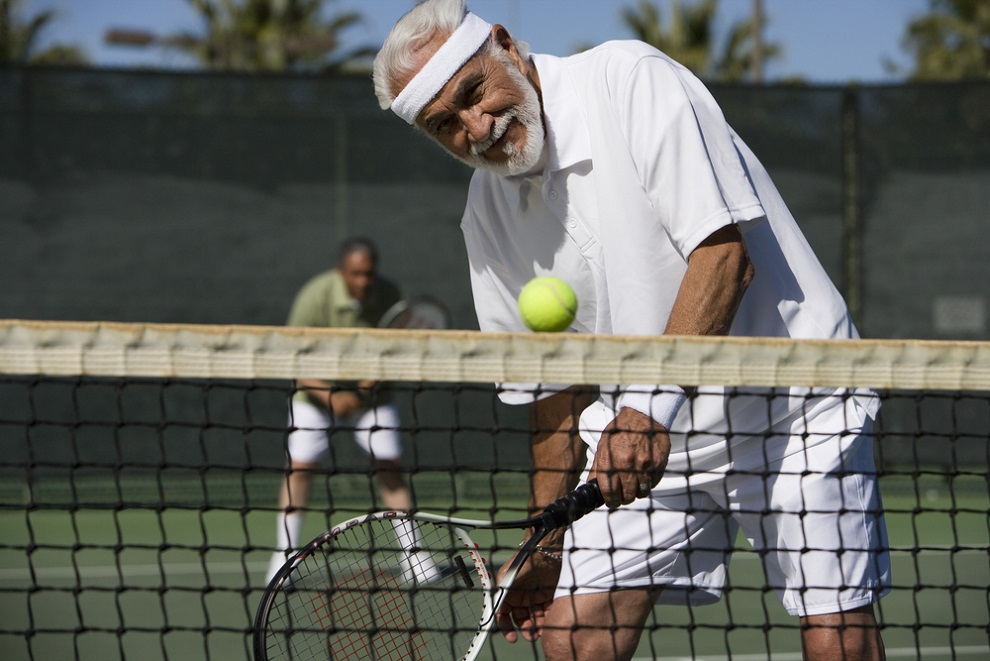Aging affects your joints in noticeable ways. Over time, the wear and tear from everyday use leads to joint aging. Many people experience joint problems ranging from mild stiffness to significant discomfort, making even simple movements harder.
Aging and regular use of joints gradually affect cartilage, the tissue that cushions joints. As this cushioning wears down, joints become less flexible. Studies suggest that around 25% of adults over 50 experience joint pain, particularly in weight-bearing areas like hips and knees. Therefore, maintaining joint health as you age is vital to staying active and independent.
This blog provides practical ways to support aging joints, as well as highlights how aging impacts joint health, and addresses some common challenges. We will also discuss preventive measures, exercise routines, and dietary suggestions to maintain joint mobility and reduce pain.

How Aging Affects Bones, Muscles, and Joints?
With age, bones naturally become more fragile due to a decrease in bone mineral density. One of the most noticeable changes is the loss of bone mass.
Over time, bones lose calcium, which reduces their density and makes them thinner. This makes fractures more common, limiting mobility and impacting daily activities. Another change is the way the spine shortens over time because of disk degeneration. This can affect posture and flexibility, making even simple movements harder and contributing to back pain.
Muscles face their own set of age-related challenges. Muscle fibers shrink, which leads to less muscle mass and weaker muscles overall. As lean body mass decreases, you may feel less steady, experience slower movements, and notice a decline in balance. People with low testosterone levels, which naturally decline with age, may find that their joints and muscles become weaker over time.
Research highlights that adults lose approximately 3-8% of their muscle mass per decade after the age of 30, with the rate accelerating after age 60. In such cases, it's common to notice that carrying groceries or going upstairs becomes harder. The decline in muscle tissue strength also makes you feel fatigued and can make activities you once enjoyed more challenging.
Joints undergo significant changes as we age. The Arthritis Foundation reports that over 54 million Americans have arthritis, a number expected to reach 78 million by 2040. Synovial membranes, which help lubricate and cushion joints, can thicken or lose elasticity, making movement less fluid.
Disks between vertebrae gradually lose fluid, impacting their ability to absorb shocks and causing stiffness and pain. Weight-bearing joints, such as the knees and hips, experience cartilage breakdown, limiting flexibility and causing joint pain.
Typical Challenges with Aging Joints
As we age, our joints naturally face wear and tear, leading to various symptoms and visual changes. Let's look at some common issues to help you recognize when it's time to take action to manage joint health.
Joint Problems and Symptoms
Aging joints often come with various symptoms that can affect daily life. Joint pain is one of the most common issues, starting with mild stiffness and gradually progressing to more persistent pain.
Minor stiffness might come and go, but it can become a daily struggle over time. Abnormal sensations, like tingling or instability, can also signal joint problems. When joints, especially in the knees, hips, and fingers, become affected, moving them can feel harder and more uncomfortable.
This can limit your ability to do everyday tasks, from walking to picking up objects. For many, this is the early stage of arthritis, which can become debilitating without proper care.
Visual Signs of Joint Wear
You can notice visible signs of joint wear as you age. One common indicator is cartilage loss, which can be especially noticeable in the finger joints.
This can cause swelling, pain, and reduced mobility. When cartilage breaks down, the bones start rubbing against each other, causing discomfort. Hip and knee joints are vulnerable to these changes, including the growth of bone spurs, also called osteophytes.
These bony outgrowths develop due to joint stress and can cause pain when bending or putting weight on the joint. Bone spurs cause motion limitation, making walking or climbing stairs difficult.
Prevention and Maintenance Through Exercise
Regular exercise is important for keeping your joints healthy. Moderate exercise can help maintain joint mobility, support muscle strength, and reduce the risk of injuries.
Weight-bearing activities are particularly beneficial as they help build and maintain bone mass density, which often decreases with age. Starting a new exercise program may feel daunting initially, but even light activities can lead to great benefits over time.
The key is consistency, which helps prevent joint pain and stiffness and supports overall joint function. A moderate exercise program can make a real difference in maintaining joint health. Adding the right exercises to your routine keeps your joints healthy and moving smoothly.
Here are some effective exercises that target various joints:
Low-Impact Activities for Aging Joints
These activities are gentle on the joints while still providing an effective workout. Walking is one of the simplest and most accessible options for maintaining knee joint health. It helps keep joints moving without causing undue stress.
Water aerobics are an excellent choice for joint health. The buoyancy of the water supports the body and reduces the impact on the joints. This makes water aerobics ideal for those experiencing joint pain or stiffness.
Strength Training for Aging Joints
Building muscle mass around your joints can provide better support and reduce pain. Using resistance bands or lighter weights for strength training greatly improves muscle strength and boosts stability.
Focus on lower-body exercises, such as leg lifts, gentle squats, and bridges, to help strengthen and support the knee and hip joints. Exercises like bicep curls and tricep extensions maintain muscle around the shoulders and elbows for upper body strength.
Mobility Exercises for Aging Joints
Mobility exercises keep the joints flexible and reduce the risk of stiffness. Joint rotations and arm circles are simple ways to improve shoulders and upper body flexibility.
Try leg swings or heel-toe walks for the knees to promote a range of motion. Hip circles and hip openers improve mobility in the hip joints, preventing stiffness and maintaining functional movement.
Balance and Coordination Exercises for Aging Joints
Activities that improve balance can reduce the risk of falls and injuries. Tai chi and yoga are highly effective for enhancing coordination, balance, and flexibility.
They engage the whole body and help maintain joint stability while promoting mental relaxation. Single-leg stands, and heel-to-toe walking are simple balance exercises to build strength and prevent falls.
Targeting Specific Joints
To focus on specific joints, practice ankle circles, and toe raises to strengthen the ankle joints and support the foot arches. Wrist circles and finger stretches help maintain hand mobility, preventing stiffness and joint pain.
Nutrition and Supplements for Joint Health
Taking care of your joints isn't just about physical activity; what you eat plays a big role. A well-balanced diet can give your body the nutrients it needs to support joint health and overall mobility.
This means eating the best foods for healthy joints that provide essential vitamins, minerals, and nutrients that help keep joints functioning well. A balanced diet keeps your joints comfortable and flexible, especially when paired with regular exercise.
A diet rich in whole foods, such as fruits, vegetables, lean proteins, and whole grains, supports healthy joints by providing the building blocks for muscle and tissue repair. Lean protein sources, including poultry, fish, and plant-based options, help maintain muscle mass and strength, which supports joint stability.
Additionally, omega-3 fatty acids in fish and certain plant-based foods have anti-inflammatory properties that reduce joint pain and stiffness. Some people turn to dietary supplements to boost their joint health, especially when their diet is insufficient to fulfill the requirement.
Supplements like glucosamine, chondroitin, and omega-3s can aid in maintaining joint function and reducing inflammation. Always consult your doctor and check reputable dietary supplement websites to ensure the products meet safety standards and your personal needs.
No, the article does not currently address the role of testosterone in joint health. Adding a section about how testosterone supports joint health would enhance the article's value, especially given its focus on aging and joint issues. Here's a suggested addition:
The Role of Testosterone in Aging Joints
Testosterone helps maintain overall musculoskeletal health, directly impacting joint function. As testosterone levels naturally decline with age, many men experience changes in their joints, muscles, and bones. Here's how optimal testosterone levels can support joint health:
- Stronger Muscles: Testosterone helps build and maintain muscle mass, which provides stability and support to joints, reducing strain and the risk of injury.
- Healthier Bones: By promoting bone mineral density, testosterone strengthens the structure that supports joints, lowering the risk of fractures and joint-related problems.
- Reduced Inflammation: Testosterone's potential anti-inflammatory effects may help alleviate joint pain and stiffness caused by chronic inflammation.
- Improved Cartilage Health: Emerging research suggests testosterone might play a role in maintaining cartilage, the tissue that cushions and protects joints.
If you're experiencing joint pain alongside symptoms like fatigue, muscle loss, or weight gain, low testosterone levels could be contributing. Addressing this through testosterone replacement therapy (TRT) might improve joint health and overall well-being.
Key Nutrients to Focus On
Some nutrients are vital for maintaining joint health. Bone density is important for overall joint stability, so consume calcium and vitamin D to strengthen your bones.
Magnesium and vitamin K also contribute to bone tissue strength and health. Collagen is another essential protein that helps strengthen connective tissue and support joints. It can be found in bone broth or taken as a supplement.
Managing and Treating Joint Problems
Joint problems can range from minor discomfort to more serious conditions that impact daily life. It's important to understand how to manage and treat these issues effectively. A combination of medical, therapeutic, and lifestyle approaches can make a significant difference.
Medical and Therapeutic Treatments
Consulting with geriatric or critical care medicine specialists can help manage joint issues. These professionals understand the unique needs of aging joints and can provide personalized treatment plans.
Various treatments can address the common clinical problems of joint problems, such as pain, stiffness, and swelling. Physical therapy with targeted exercises strengthens the muscles around the joint, improving stability and mobility. Occupational therapy also helps with modifying daily activities to reduce joint strain.
For some, medication such as anti-inflammatory drugs can provide temporary relief, but they should be used under the guidance of a healthcare provider. In cases where pain becomes severe or affects quality of life, your doctor may recommend additional treatments like corticosteroid or hyaluronic acid injections.
Joint Replacement Surgery
Joint replacement surgery is often considered when conservative measures do not relieve pain or restore function.
If joint problems interfere with daily tasks or limit mobility, it may be time to consult an orthopedic surgeon. The affected joint is typically evaluated using medical imaging to determine the severity of damage.
In most cases, surgery is seen as a last resort after other options have been explored. Joint replacement surgery aims to restore function and reduce pain, allowing the patient to regain mobility and quality of life.

Everyday Tips to Maintain Joint Health
Maintaining joint health goes beyond just exercise; it involves daily habits that support joint function and comfort. Make small changes in your routine to maximize long-term benefits. Some of them include the following.
Staying Active
Regular physical activity keeps your joints flexible and reduces the risk of stiffness. If you notice slowed movement or less arm swinging, this could indicate the need to incorporate more physical activity into your day.
Light exercises, such as low-impact workouts or gentle stretching, promote joint flexibility and circulation. These simple exercises support joint health and help maintain mobility as you age.
Maintaining Good Posture
Posture is key for reducing joint stress, particularly in the spine and knees. Standing tall and practicing good posture can decrease the risk of joint pain and long-term damage. Make small adjustments to improve your posture, like aligning your back and shoulders while sitting.
Incorporating Fine Movements
Small, controlled movements can help maintain joint function, especially in the hands and fingers. Gentle finger exercises and joint rotations can keep these joints active and prevent stiffness.
Reducing Repetitive Strain
Certain activities can strain your joints, leading to pain and stiffness. Repeated movements, like sitting or standing in one position for long periods, can add pressure to your joints. Short breaks to move or stretch can alleviate this strain and prevent stiffness.
Practicing Caution with High-Impact Activities
High-impact exercises like lifting heavy weights without proper form or running on hard surfaces can stress the joints. Using supportive gear such as joint braces or compression sleeves can reduce strain and provide stability.
Conclusion
Taking care of your joints doesn't have to be complicated. Simple lifestyle changes, like staying active, practicing good posture, and including gentle movements in your day, can make a real difference.
For those experiencing significant joint discomfort, muscle loss, or fatigue, low testosterone levels may be a contributing factor. Testosterone replacement therapy (TRT) can support muscle strength, reduce inflammation, and improve overall joint health, making it a valuable addition to your long-term health strategy.
Small, consistent actions, and exploring options like TRT, add up over time and can help you stay comfortable and maintain mobility as you age.

Get TRT Online
Optimize Your Hormones





